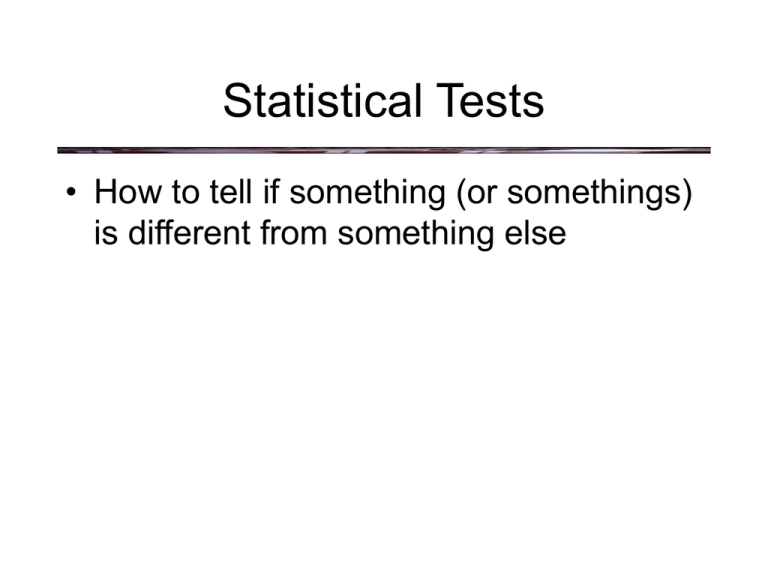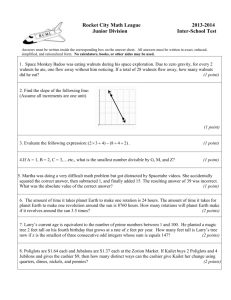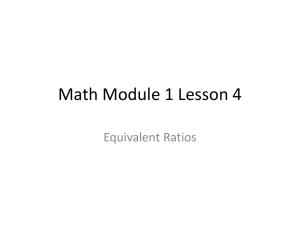Statistical Tests • How to tell if something (or somethings)
advertisement

Statistical Tests • How to tell if something (or somethings) is different from something else Populations vs. Samples • Remember that a population is all the possible members of a category that we could measure – Examples: • the heights of every male or every female • the temperature on every day since the beginning of time • Ever person who ever has, and ever will, take a particular drug Populations vs. Samples • So a population is kind of abstract typically you couldn’t ever hope to measure the entire population – Notable exceptions include: • Standardized tests (mean IQ is 100 with std. dev. of 15) • Special populations such as rare diseases or isolated groups of people Populations vs. Samples • A sample is some subset of a population – Examples: • The heights of 10 students picked at random • The participants in a drug trial Populations vs. Samples • The notation – Sample statistics are usually regular letters like s and X – Population statistics are usually greek letters like: - the population mean - the population standard deviation Populations vs. Samples • Test your intuition: – Under what circumstances does the mean of a sample equal the mean of the population from which it was drawn? – What about the standard deviation? – What if your sample was very small relative to the population? Populations vs. Samples • Test your intuition: – Most importantly: What if you took more than one sample Central Limit Theorem • There is a distribution of sample means Central Limit Theorem • There is a distribution of sample means The population of IQ scores: 100 Central Limit Theorem • There is a distribution of sample means The population of IQ scores: 100 Your Sample x = 95 Central Limit Theorem • There is a distribution of sample means The population of IQ scores: 100 Your Sample x = 103 Central Limit Theorem • There is a distribution of sample means The population of IQ scores: 100 Your Sample x = 99 Central Limit Theorem • • There is a distribution of sample means This is the sampling distribution of the mean Central Limit Theorem • What is the mean of the sampling distribution of the mean? – mean of the sampling distribution approaches the mean of the population with many resamplings x u Central Limit Theorem • What is the standard deviation of the sampling distribution of the mean? – The standard error of the mean X n Notice it will always be less than the standard deviation of the population! Central Limit Theorem • What is the shape of the sampling distribution of the mean? – Central Limit Theorem: the sampling distribution of the mean is normal regardless of the shape of the underlying distribution ! – This means you can use the Z transform and use the Z table The Logic of Statistical Tests Statistical Tests • Consider a simple example: – you are testing the hypothesis that eating walnuts makes people smarter by feeding walnuts to a group of 30 subjects and then testing their IQ Statistical Tests • Consider a simple example: – you are testing the hypothesis that eating walnuts makes people smarter by feeding walnuts to a group of 30 subjects and then testing their IQ – If you are right, then eating walnuts will make the average IQ of your subjects be higher than the average IQ of all people (the population) since, mostly, those other people don’t eat walnuts much Statistical Tests • Consider a simple example: – Put another way: • Is this sample (entirely) of walnut eaters different from the population of mostly nonwalnut-eaters Types of Errors • There are two “mistakes” you could make: Types of Errors • There are two “mistakes” you could make: – Type I error or False-Positive - you decide the walnut treatment works when it doesn’t really – Type II error or False-Negative - you decide the walnuts don’t work when really they do Types of Successes • There are two ways to succeed: – Hit or True-Positive: You decide the walnuts do make people smarter and, in fact, they really do – Correct-Rejection or True-Negative: You decide the walnuts don’t work and, in fact they really don’t Outcome Matrix Actual Situation Works “Works” Doesn’t Work True Positive Type I Your Conclusion “Doesn’t Work” Type II TrueNegative Statistical Tests • Consider a simple example: – Your subjects turn out to have a mean IQ of 107.5 (1/2 S.D. from the mean of the population) after eating walnuts Statistical Tests • What are two reasons why the mean IQ of your subjects might be greater than the mean of the population? 1. you happened to pick 30 very smart people (i.e. university students) – WARNING: Type I error is possible! Statistical Tests • What are two reasons why the mean IQ of your subjects might be greater than the mean of the population? 1. you happened to pick 30 very smart people (i.e. university students) – WARNING: Type I error is possible! 2. the walnuts worked Statistical Tests • Usually we are worried about making a type I error so we need to know: – What fraction of all possible groups of 30 subjects would have a mean IQ of 105 or less? Statistical Tests • Usually we are worried about making a type I error so we need to know: – What fraction of all possible groups of 30 subjects would have a mean IQ of 105 or less? • In other words, we are interested not in the distribution of IQ scores themselves, but rather in the distribution of mean IQ scores for groups of 30 subjects The Z Test …as it is more formally known Example Z Test • Using our example in which we are testing the hypothesis that walnuts make people smarter • null hypothesis is that they don’t X = 107.5 = 100 = 15 Example Z Test • Using our example in which we are testing the hypothesis that walnuts make people smarter (null hypothesis was that they don’t) X = 107.5 100 = 15 • We wantto know how many standard errors from the mean (of the sampling distribution of means) is 107.5 Example Z Test Here’s what we’ve got: X = 107.5 ux 100 = 15 n = 30 Here’s what we can compute: Zx x x x X n That’s what we’re after so that we can use the Z table Example Z Test Here’s what we’ve got: X = 107.5 ux 100 = 15 n = 30 Here’s what we can compute: 15 X 2.739 n 30 Which is much less than 15! Example Z Test Here’s what we’ve got: X = 107.5 ux 100 = 15 n = 30 X 2.739 Here’s what we can compute: Zx x x x 107.5 100 2.738 2.739 Example Z Test Here’s what we’ve got: X = 107.5 ux 100 = 15 n = 30 X 2.739 Zx 2.738 ThusX = 107.5 isn’t half a standard deviation from the sampling distribution mean! It’s actually more than two and a half standard deviations from the sampling distribution mean ! Example Z Test Here’s what we’ve got: X = 107.5 ux 100 = 15 n = 30 X 2.739 Zx 2.738 Looking up 2.739 in the Z table reveals that only .0031 or .31% of the means in the sampling distribution of mean IQs (for groups of 30 people each) would have a mean equal to or greater than 107.5! Example Z Test • What this means is that you have only a 0.31% chance of making a type I error if you conclude that walnuts made your subjects smarter ! Example Z Test • What this means is that you have only a 0.31% chance of making a type I error if you conclude that walnuts made your subjects smarter ! • Put another way, there is only a 0.31% chance that this sample of IQs is taken from the regular population…walnut eaters are different Alpha • Is .31% small enough? What risk of making a Type I error is too great? Alpha • Is .31% small enough? What risk of making a Type I error is too great? • There is no absolute answer - it depends entirely on the circumstances Alpha • Is .31% small enough? What risk of making a Type I error is too great? • There is no absolute answer - it depends entirely on the circumstances • 5% or probability (p) = .05 is generally accepted Alpha • Is .31% small enough? What risk of making a Type I error is too great? • There is no absolute answer - it depends entirely on the circumstances • 5% or probability (p) = .05 is generally accepted • This rate of making Type I errors (ie. number of Type I errors per 100 experiments) is called the Alpha Level Statistical Significance • So we conclude that walnuts have a statistically significant effect on IQ with a probability of a Type I error of less than 5% – In a research article we might say “the effect of walnuts on IQ was significant (one-tailed Z test, p = .0031)”



